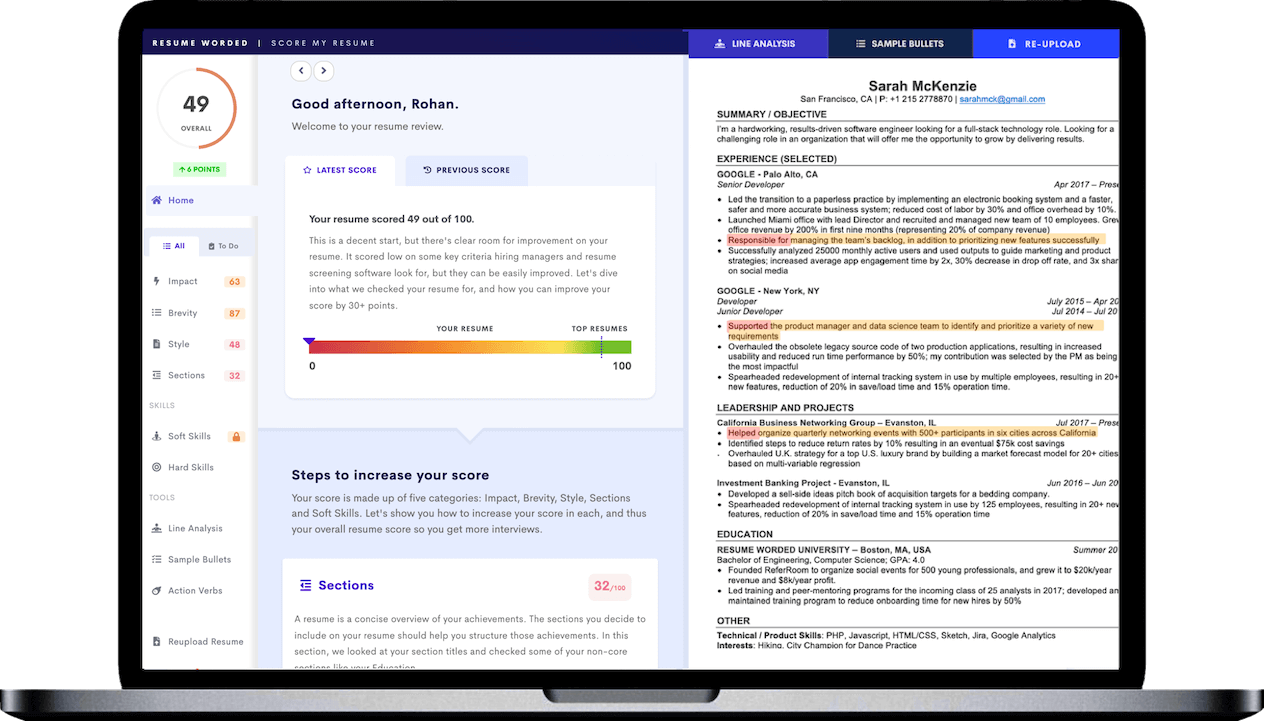When it comes to academic achievements, Latin honors — like cum laude, magna cum laude, and summa cum laude — are some of the most prestigious. But does that mean they deserve an automatic spot on your resume? Well, yes, actually — as long as you follow a few simple guidelines. In this guide, we’ll walk you through the do’s and don’t for listing cum laude on a resume, including resume examples you can use.
How to list cum laude on a resume
There are a few different places where you can include cum laude on a resume:
- In the education section
- In a separate honors and awards section
- In an additional section
Not sure which one is right for you? Here’s how to choose.
Listing Latin honors in an education section
If you’re a current student or recent graduate, highlighting Latin honors like cum laude is a great way to make your resume stand out until you have more relevant work-related accomplishments.
When: This is the best (and most obvious) option for listing cum laude, magna cum laude, and summa cum laude on your resume. Include Latin honors in your education section unless you have a compelling reason to list them elsewhere instead.
How: If you graduated recently and your degree is the most relevant thing on your resume, your education section can go at the top of your resume. This can take up a little more space than usual and include cum laude as well as other honors, awards, GPA, relevant coursework, and study abroad.
Example:
Alternatively, if you graduated a little while ago and are applying for mid-level or higher roles, you can still include Latin honors in the education section of your resume without taking up too much space.
When: If you want to include prestigious honors like cum laude without wasting valuable resume real estate.
How: Keep your education section brief and include it underneath your professional experience. Include the university, degree, and date of graduation (optional). List cum laude on the same line.
Example:
Listing cum laude in a separate honors and awards section
If you can afford to carve out a little more space — like if you’re new to the workforce and your resume is very short — you can consider creating a separate awards section on your resume.
When: If you have a lot of awards or other honors you want to highlight. Only do this if your education was very recent — once you have at least one professional job under your belt, hiring managers care more about work accomplishments than they do about your education, no matter how prestigious.
How: Create a section toward the bottom of your resume and title it “Honors & Awards.” Include cum laude along with any other relevant honors, like Dean’s List or similar academic awards.
Example:
An example of a separate honors and awards section on a resume including magna cum laude
Listing cum laude in an additional resume section
Don’t want to spend too much time — or space — listing out academic honors? Latin honors can also go in an additional section at the end of your resume.
When: If you’re low on space or want to include a few miscellaneous things that don’t really belong anywhere else on your resume.
How: At the very bottom of your resume, create a section titled “Other” or “Additional Information.” Include a subheading like “Awards” and list cum laude on a single line alongside any other honors or awards.
Example:
If you’re not sure if you’ve chosen the right section to include cum laude on your resume, upload it to the tool below — it’ll scan your resume sections and let you know if you’ve listed cum laude and other honors the right way.
Tips for including cum laude on a resume
When should you include cum laude on a resume?
Unlike other academic details, Latin honors like cum laude, magna cum laude, and summa cum laude are prestigious enough that they can stay on your resume long after you’ve graduated. If you’re worried about not having enough space, see above for examples of how to include cum laude on a resume without taking up any extra lines.
This goes double if you’re applying to grad school or for positions in academia — in these cases, academic performance is more relevant than it would be for other professional jobs.
How do you format cum laude on a resume?
Latin honors should be written in lower case and italics on a resume.
Right:
cum laude
magna cum laude
summa cum laude
Wrong:
Cum laude
Magna Cum Laude
summa Cum Laude
What do Latin honors mean?
Translated from Latin, cum laude literally means “with praise.” It’s automatically awarded to graduates in a certain percentile of their graduating class — usually, the top 20%, 25%, or 30% of graduates.
Similarly, magna cum laude means “with great praise” and summa cum laude means “with highest praise.” Of all Latin honors, summa cum laude is the most prestigious, typically awarded to the top 1%, 2%, or 5% of a graduating class.
What else should you include in the education section of your resume?
This depends on how recently you graduated — as a general rule, as you gain more professional work experience, you should include less information about your education. At a bare minimum, always include the name of the institution and the degree you studied. If you’re listing Latin honors on a resume, you may want to include your GPA, since the exact GPA requirements for cum laude, magna cum laude, and summa cum laude vary between different schools.
How can you check if you’ve listed Latin honors currently on a resume?
The quickest — and easiest — way is to upload your resume to an ATS resume scanner that can give you feedback and advice on how to optimize your resume and impress recruiters.
For more general information on formatting your resume education section, you can also check out our guides on the must-haves when writing your education on your resume and how to list honors on your resume.










